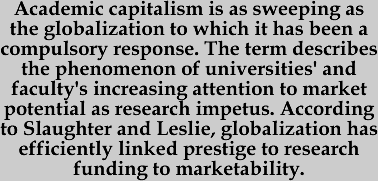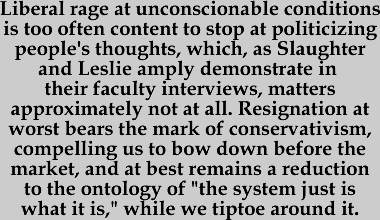|

Academic Capitalism: Politics, Policies and
the Entrepreneurial University
by Sheila
Slaughter and Larry L. Leslie
Johns Hopkins
UP, 1997
Elizabeth Mazzolini
1. Slaughter and Leslie's book presents formidable sets of statistics and
policy research that demonstrate the decreasing degree to which higher
education is beholden to the public good, and the increasing degree to
which higher education is obligated to the extra-academic market. As universities are  forced by diminishing public funds to raise tuition, faculty likewise are
forced by diminishing support from their universities to seek outside
funding. This places faculty in the position of having to anticipate
and answer to the vagaries of the market. Research, according to
Slaughter and Leslie, has become less "curiosity-driven" and more market-driven. Faculty's
enslavement to market whims is further ensured by not only less public
money, but also less control over what little money there is. Unlike
the unconditional love that characterizes undesignated public funds, money
from external sources is doled out conditionally, as from a stingy aunt
who demands that you perform "I'm a Little Teapot" for your birthday money. Market
money comes with the expectation that there will be returns from the investment
in the form of profitable products or processes. The period that
Slaughter and Leslie write about, approximately 1970-1990, has been marked
by dramatic declines in block grants—unconditional love funds from the federal government granted to universities
to use as they see fit—and a concomitant increase in academic capitalism, Slaughter and Leslie's
titular neologism. forced by diminishing public funds to raise tuition, faculty likewise are
forced by diminishing support from their universities to seek outside
funding. This places faculty in the position of having to anticipate
and answer to the vagaries of the market. Research, according to
Slaughter and Leslie, has become less "curiosity-driven" and more market-driven. Faculty's
enslavement to market whims is further ensured by not only less public
money, but also less control over what little money there is. Unlike
the unconditional love that characterizes undesignated public funds, money
from external sources is doled out conditionally, as from a stingy aunt
who demands that you perform "I'm a Little Teapot" for your birthday money. Market
money comes with the expectation that there will be returns from the investment
in the form of profitable products or processes. The period that
Slaughter and Leslie write about, approximately 1970-1990, has been marked
by dramatic declines in block grants—unconditional love funds from the federal government granted to universities
to use as they see fit—and a concomitant increase in academic capitalism, Slaughter and Leslie's
titular neologism.
2.
Academic capitalism is as sweeping as the globalization to which it has
been a compulsory response. The term describes the phenomenon of
universities' and faculty's increasing attention to market potential as
research impetus. According to Slaughter and Leslie, globalization
has efficiently linked prestige to research funding to marketability.
Slaughter and Leslie point out that federal research and development policies
have, especially since World War II, emphasized the technological as being
key for global competitiveness, so that academic capitalism is most visible
in applied science and technology departments. There is a trickle-down
effect for the humanities, in an increasing reliance on communication
training, valuable in corporate settings. In other words, the humanities
are useful only insofar as they support the most marketable research coming
out of the university.
3. Academic Capitalism's geographic scope,
encompassing four English-speaking countries (the United States, the United
Kingdom, Canada, and Australia), supports its global-scale argument, and
moreover reinforces arguments about governmental policies from a non-Americo-centric
point of view. This combined with its broad temporal scope makes
the book's argument about globalization dauntingly convincing. Oddly,
much of the support for its case comes in the extremely local form of
faculty interviews at Australian universities. Using these individual
perceptions as evidence perhaps costs Slaughter and Leslie something in
terms of prescriptive foothold, and relegates them to a rage-or-resignation
logic that belies what they gain in documenting a policy trend.
4.
The history of the present that Slaughter and Leslie illustrate in Academic
Capitalism is a compelling picture of a less-than-ideal form for higher
education. Without detracting from the force of that illustration,
Slaughter and Leslie rely heavily on the idealistic model of research
assumed by their study before it even began. If the global economy
brought a flood of new and more intense kinds of investments in competition
between nations, Slaughter and Leslie's antediluvian university was one
characterized by scholars whose work was animated by pure love for knowledge,
unfettered by the cynicizing bonds of market application. On this
view, the university was a bastion of pure inquiry, independent and protected
from the nasty outside world where people do things in order to make money. Certainly,
the book seems to assume, there would be no such self-interest in an academy
if left to its own devices, supported by the plenitude of unconditional
public support, without the dynamic introduced by the encroaching global
economy and its governmental responses. In order to compete in the global
marketplace, Academic Capitalism points out that governments must
ensure that their countries develop applicable and marketable goods. Universities
have become the less expensive surrogates of corporate R & D departments
for those goods.
5.
The book's assumption that commercial competitiveness sullies academic
research indicates not only an idealized past, but also an idealized separation
of academy from market. However, even the universities of yore that were
not dancing for the dollars of the stingy aunt were deeply structured
by class and economic forces. My own university started as one of
several land grant institutions that were set  aside
for agricultural research in the nineteenth century. Currently this
same university has high-profile contracts with Nike, Pepsi, Barnes and
Noble, and the U.S. Defense Department. Contemporary sources of funding
seem quite different in kind from early federal subsidies for agriculture,
but to suggest, as I take Slaughter and Leslie to do, that it is only
after World War II that knowledge production had economic impetus is strikingly
inaccurate. On a smaller scale, market forces circulate within departments,
and moreover cannot be separated from curiosity. For example, in
an English department, my research interests and those of my colleagues
emerge from previous scholarship that got published and contributed toward
jobs and tenure because of its particularized market value. Along
with Slaughter and Leslie, it seems obvious that marketable technology
has cultural pride of place. However, market forces are locally as
well as globally constitutive, not, as Academic Capitalism
maintains, instrumental and external to what they operate on. As
such, they work not only visibly and sometimes hamhandedly but also subtly
and more importantly, axiomatically. Attending and objecting to federal-level
policy stakes out grounds of righteousness that threaten to cripple structural
responses, such as local academic labor unions. aside
for agricultural research in the nineteenth century. Currently this
same university has high-profile contracts with Nike, Pepsi, Barnes and
Noble, and the U.S. Defense Department. Contemporary sources of funding
seem quite different in kind from early federal subsidies for agriculture,
but to suggest, as I take Slaughter and Leslie to do, that it is only
after World War II that knowledge production had economic impetus is strikingly
inaccurate. On a smaller scale, market forces circulate within departments,
and moreover cannot be separated from curiosity. For example, in
an English department, my research interests and those of my colleagues
emerge from previous scholarship that got published and contributed toward
jobs and tenure because of its particularized market value. Along
with Slaughter and Leslie, it seems obvious that marketable technology
has cultural pride of place. However, market forces are locally as
well as globally constitutive, not, as Academic Capitalism
maintains, instrumental and external to what they operate on. As
such, they work not only visibly and sometimes hamhandedly but also subtly
and more importantly, axiomatically. Attending and objecting to federal-level
policy stakes out grounds of righteousness that threaten to cripple structural
responses, such as local academic labor unions.
6. Slaughter and Leslie's argument shares its logic with a lot of other and
other kinds of arguments, both quantitative and polemical, that themselves
occupy a niche market in academic publishing and hiring. The logic
that warrants these arguments pitches the possible responses as the rage-or-resignation
to which I alluded. Liberal rage at unconscionable conditions is
too often content to stop at politicizing people's thoughts, which, as
Slaughter and Leslie amply demonstrate in their faculty interviews, matters
approximately not at all. Resignation at worst bears the mark of
conservativism, compelling us to bow down before the market, and at best
remains a reduction to the ontology of "the system just is what it is,"
while we tiptoe around it. Slaughter and Leslie's book does valuable
work for people interested in large-scale movements in higher education. It
provides a quantitative partner to polemics, though I greet its logic
with a great deal of skepticism.
|
![]()
 forced by diminishing public funds to raise tuition, faculty likewise are
forced by diminishing support from their universities to seek outside
funding. This places faculty in the position of having to anticipate
and answer to the vagaries of the market. Research, according to
Slaughter and Leslie, has become less "curiosity-driven" and more market-driven. Faculty's
enslavement to market whims is further ensured by not only less public
money, but also less control over what little money there is. Unlike
the unconditional love that characterizes undesignated public funds, money
from external sources is doled out conditionally, as from a stingy aunt
who demands that you perform "I'm a Little Teapot" for your birthday money. Market
money comes with the expectation that there will be returns from the investment
in the form of profitable products or processes. The period that
Slaughter and Leslie write about, approximately 1970-1990, has been marked
by dramatic declines in block grants—unconditional love funds from the federal government granted to universities
to use as they see fit—and a concomitant increase in academic capitalism, Slaughter and Leslie's
titular neologism.
forced by diminishing public funds to raise tuition, faculty likewise are
forced by diminishing support from their universities to seek outside
funding. This places faculty in the position of having to anticipate
and answer to the vagaries of the market. Research, according to
Slaughter and Leslie, has become less "curiosity-driven" and more market-driven. Faculty's
enslavement to market whims is further ensured by not only less public
money, but also less control over what little money there is. Unlike
the unconditional love that characterizes undesignated public funds, money
from external sources is doled out conditionally, as from a stingy aunt
who demands that you perform "I'm a Little Teapot" for your birthday money. Market
money comes with the expectation that there will be returns from the investment
in the form of profitable products or processes. The period that
Slaughter and Leslie write about, approximately 1970-1990, has been marked
by dramatic declines in block grants—unconditional love funds from the federal government granted to universities
to use as they see fit—and a concomitant increase in academic capitalism, Slaughter and Leslie's
titular neologism.  aside
for agricultural research in the nineteenth century. Currently this
same university has high-profile contracts with Nike, Pepsi, Barnes and
Noble, and the U.S. Defense Department. Contemporary sources of funding
seem quite different in kind from early federal subsidies for agriculture,
but to suggest, as I take Slaughter and Leslie to do, that it is only
after World War II that knowledge production had economic impetus is strikingly
inaccurate. On a smaller scale, market forces circulate within departments,
and moreover cannot be separated from curiosity. For example, in
an English department, my research interests and those of my colleagues
emerge from previous scholarship that got published and contributed toward
jobs and tenure because of its particularized market value. Along
with Slaughter and Leslie, it seems obvious that marketable technology
has cultural pride of place. However, market forces are locally as
well as globally constitutive, not, as Academic Capitalism
maintains, instrumental and external to what they operate on. As
such, they work not only visibly and sometimes hamhandedly but also subtly
and more importantly, axiomatically. Attending and objecting to federal-level
policy stakes out grounds of righteousness that threaten to cripple structural
responses, such as local academic labor unions.
aside
for agricultural research in the nineteenth century. Currently this
same university has high-profile contracts with Nike, Pepsi, Barnes and
Noble, and the U.S. Defense Department. Contemporary sources of funding
seem quite different in kind from early federal subsidies for agriculture,
but to suggest, as I take Slaughter and Leslie to do, that it is only
after World War II that knowledge production had economic impetus is strikingly
inaccurate. On a smaller scale, market forces circulate within departments,
and moreover cannot be separated from curiosity. For example, in
an English department, my research interests and those of my colleagues
emerge from previous scholarship that got published and contributed toward
jobs and tenure because of its particularized market value. Along
with Slaughter and Leslie, it seems obvious that marketable technology
has cultural pride of place. However, market forces are locally as
well as globally constitutive, not, as Academic Capitalism
maintains, instrumental and external to what they operate on. As
such, they work not only visibly and sometimes hamhandedly but also subtly
and more importantly, axiomatically. Attending and objecting to federal-level
policy stakes out grounds of righteousness that threaten to cripple structural
responses, such as local academic labor unions. 